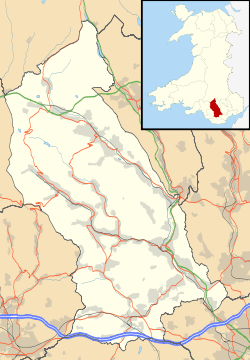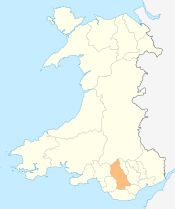Hirwaun
| Hirwaun | |
 Hirwaun War Memorial |
|
 Hirwaun |
|
| Population | 4,990 |
|---|---|
| OS grid reference | SN966055 |
| Principal area | Rhondda Cynon Taf |
| Ceremonial county | Mid Glamorgan |
| Country | Wales |
| Sovereign state | United Kingdom |
| Post town | ABERDARE |
| Postcode district | CF44 |
| Dialling code | 01685 |
| Police | South Wales |
| Fire | South Wales |
| Ambulance | Welsh |
| EU Parliament | Wales |
| UK Parliament | Cynon Valley |
| Welsh Assembly | Cynon Valley |
|
|
Coordinates: 51°44′19″N 3°29′56″W / 51.73864°N 3.49887°W
Hirwaun (Welsh "Long Meadow") is a village at the north end of the Cynon Valley in the County Borough of Rhondda Cynon Taf, South Wales. It is 4 miles (6 km) NW of the town of Aberdare, and comes under the Aberdare post town. At the 2001 census, Hirwaun had a population of 4,851.[1] increasing at the 2011 census to 4,990.[2] The village is on the Heads of the Valleys Road and at the southern edge of the Brecon Beacons National Park.
History and Background
Hirwaun has an industrial background centring on the Hirwaun Ironworks. After the ironworks closed, coal mining continued, and was a major employer until the second half of the 20th century.
The Crawshay family were powerful, almost all-powerful in the production of steel, and the Hirwaun Ironworks had produced cannons used on HMS Victory. The family owned a large portion of Hirwaun and even used their own currency, the "Hirwaun Guinea", to pay employees, a form of truck system which stopped employees travelling to Cardiff or spending their money outside the controlled economy of the village.[3]
Following the miners' strike, the only deep coal mine left in Wales was Tower Colliery, which closed down, was bought by its workers and reopened.
Industry
Anthony Bacon started iron production at Cyfarthfa in 1765. His business partner, Francis Homfray, ran the works during the Napoleonic Wars. The finished product was transported to the port of Cardiff by mules and pack-horses.[4] The works later passed through a succession of owners before being purchased in 1819 by William Crawshay of Cyfarthfa. Crawshay expanded the works, leading to a population influx into the locality.[5] By 1830, nearly 900 men were employed at the Hirwaun works, and in the same year the first railway steam engine seen in the locality began to operate from the works.[4] The ironworks remained in family hands until its closure in 1859. The ironworks' blast furnaces required coke, which spurred an increase in local coal mining.
Government
Hirwaun had its own seat on Glamorgan County Council from 1889. The first member elected was Sir William Thomas Lewis, later Lord Merthyr. Hirwaun was also part of the Aberdare Urban District Council area.
Religion
St Lleurwg's Church
Saint Lleurwg's parish church is in the centre of the village, in the ecclesiastical parish of Hirwaun. It was opened by the Bishop of Llandaff in July 1858. The sister church in the parish, in Penywaun, is dedicated to Saint Winefred.
Nonconformist Chapels
There were a number of nonconformist chapels in Hirwaun village, most dating from its early days as an industrial settlement when large numbers of people arrived from rural Wales. The chapels included Ramoth (Baptist), Nebo (Congregationalist) and Soar (Wesleyan Methodist).
During the 1904-05 Religious Revival, Evan Roberts, the main instigator of the movement, visited the village.[6]
Architecture
Unlike most South Wales Coalfield villages, Hirwaun has an array of different architectural housing styles, often cheek-by-jowl in small blocks. This is due to developments to satisfy different needs at different times, with much gentrification in the last few decades. So Hirwaun has a discontinuous, hotch-potch feel to it that marks it out as unusual in the South Wales Valleys.
The tower blocks
Hirwaun made local news in May 2004 when its two 1960s-built tower blocks were demolished by dynamite detonation. Their demise marked the end of a major landmark in the Cynon Valley and was symptomatic of a broader failure in the design of British public housing.[7]
Hirwaun Common development
Currently the patch of green land known as Hirwaun Common is being strip mined again. This was first done in the 1940s and 1950s.
Transport
The village was originally served by Hirwaun railway station on the Vale of Neath Railway, which arrived in 1851. At Gwelli Junction north of the station, the mainline from Neath to Merthyr Tydfil met the Vale of Neath Railway branch to Aberdare and the Aberdare Railway. South of the station were the goods yard and sidings which served the various industries in the area, including Hirwaun Ironworks, Tower Colliery, two brickworks, and Penderyn quarry tramway.
With the Beeching Axe in 1963, the lines south to Neath and north to Merthyr and the former Aberdare Railway were all closed. Hirwaun station was demolished. The line north to Aberdare on the Merthyr Line to Cardiff Central was only kept open for coal traffic to Tower Colliery, which moved its coal washery and loading facility onto the site of the former station goods yard.
After the second closure of Tower in early 2008, in November 2009 the Welsh Assembly Government (WAG) asked Network Rail to conduct a feasibility study on reopening the line to Hirwaun for passenger services.[8] After clearing the line of vegetation, Network Rail submitted its report to WAG, who in March 2011 announced that enough funds had been allowed in the 2011-12 capital programme to allow the reopening of the line to Hirwaun as part of the Cynon Valley Scheme.[9] However, there is currently no information on when the work will commence and when the line will reopen.
Sport
Hirwaun RFC currently play in the SWALEC League 5 South Central.
Hirwaun has a number of football teams: Hirwaun & Mackworth FC, Hirwaun Sports, Lamb FC, and FC Hirwaun (formerly Glancynon FC)
Hirwaun & Mackworth FC are currently the highest ranked in the pyramid system, playing in the South Wales Amateur Football League.
Hirwaun Sports, Lamb FC, and Hirwaun FC compete in the Aberdare Valley Football League.
The aims of the Hirwaun Community Sports Association are to promote sport within the village and also to create and improve sporting facilities.
Hirwaun Recreational Ground, known locally as the Welfare Ground, is the main sporting facility in the village. The ground has one soccer field, one Rugby Union field, two tennis courts (hard surface) and a bowling green. The ground also includes a floodlit training area, between the two fields. Changing facilities are available on site.
Notable people
- See also Category:People from Hirwaun
- Gareth Evans, film director
References
- ↑ Davies, John; Jenkins, Nigel (2008). The Welsh Academy Encyclopaedia of Wales. Cardiff: University of Wales Press. p. 369. ISBN 978-0-7083-1953-6.
- ↑ "Community population 2011". Retrieved 16 November 2015.
- ↑ Cyfarthfa Ironworks Old Merthyr Tydfil
- 1 2 Rees. Chapels in the Valley. pp. 124–5.
- ↑ Jones. "Thomas Price (Part One)": 149–50.
- ↑ "Evan Roberts at Hirwaun". Aberdare Leader. 21 January 1905. p. 5. Retrieved 15 October 2016.
- ↑ http://www.pash-living.co.uk/blog/contemporary-designers/le-corbusier-enfant-terrible-of-modernist-architecture.html
- ↑ "Old tracks could see trains again". BBC News. 6 November 2009.
- ↑ http://www.walesonline.co.uk/news/local-news/aberdare/2011/03/24/aberdare-to-hirwaun-rail-line-set-to-reopen-91466-28381233/
Bibliography
- Jones, Alan Vernon (2004). Chapels of the Cynon Valley. Cynon Valley Historical Society. ISBN 0953107612.
- Jones, Ieuan Gwynedd (1964). "Dr. Thomas Price and the election of 1868 in Merthyr Tydfil : a study in nonconformist politics (Part One)". Welsh History Review. 2 (2): 147–172.
- Rees, D. Ben (1975). Chapels in the Valley. Ffynnon Press.
External links
| Wikimedia Commons has media related to Hirwaun. |
